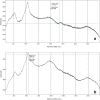Utilization of non-pathogenic bacteria to obtain optimum biofilm production for beneficial applications
- PMID: 37389797
- PMCID: PMC10484866
- DOI: 10.1007/s42770-023-01044-9
Utilization of non-pathogenic bacteria to obtain optimum biofilm production for beneficial applications
Abstract
Depending on the bacteria embedded in the extracellular polymeric layer, biofilms can be advantageous or harmful. The isolated strains used in this investigation are already established to be beneficial biofilm-producing bacteria. In order to use them effectively in various domains, it is necessary to characterize them and understand their ideal physiological characteristics for maximum biofilm growth. This study used genome sequence analysis to identify and characterize strains isolated from water samples in Raipur, Chhattisgarh, India. The nucleotide sequences were submitted to NCBI GenBank under the accession numbers Bacillus tequilensis (MN889418) and Pseudomonas beteli (MN889419) and the strains were further characterized using some advanced techniques (phase contrast microscopy, Raman spectroscopy, Fourier-transform infrared spectroscopy, and scanning electron microscope). For maximum biofilm formation by isolated bacterial strains, many physiochemical factors including incubation duration, temperature, pH, carbon source concentration, and nitrogen source concentration were further examined and optimized. The fact that these non-pathogenic strains were found in public water supplies is another important part of this research because there is a chance that they could change into pathogenic state in future and cause disease in humans.
Keywords: Biofilm; Non-pathogenic; Optimization; Physiochemical factors.
© 2023. The Author(s) under exclusive licence to Sociedade Brasileira de Microbiologia.
Conflict of interest statement
The authors declare no competing interests.
Figures










Similar articles
-
Application of lipopeptide biosurfactant isolated from a halophile: Bacillus tequilensis CH for inhibition of biofilm.Appl Biochem Biotechnol. 2013 Nov;171(6):1362-75. doi: 10.1007/s12010-013-0428-3. Epub 2013 Aug 17. Appl Biochem Biotechnol. 2013. PMID: 23955294
-
Inferring characteristics of bacterial swimming in biofilm matrix from time-lapse confocal laser scanning microscopy.Elife. 2022 Jun 14;11:e76513. doi: 10.7554/eLife.76513. Elife. 2022. PMID: 35699414 Free PMC article.
-
Bacteria of eleven different species isolated from biofilms in a meat processing environment have diverse biofilm forming abilities.Int J Food Microbiol. 2021 Jul 2;349:109232. doi: 10.1016/j.ijfoodmicro.2021.109232. Epub 2021 May 4. Int J Food Microbiol. 2021. PMID: 34022615
-
Raman microspectroscopy, surface-enhanced Raman scattering microspectroscopy, and stable-isotope Raman microspectroscopy for biofilm characterization.Anal Bioanal Chem. 2017 Jul;409(18):4353-4375. doi: 10.1007/s00216-017-0303-0. Epub 2017 Apr 7. Anal Bioanal Chem. 2017. PMID: 28389920 Review.
-
Biofilm Formation and Control of Foodborne Pathogenic Bacteria.Molecules. 2023 Mar 7;28(6):2432. doi: 10.3390/molecules28062432. Molecules. 2023. PMID: 36985403 Free PMC article. Review.
References
MeSH terms
LinkOut - more resources
Full Text Sources

